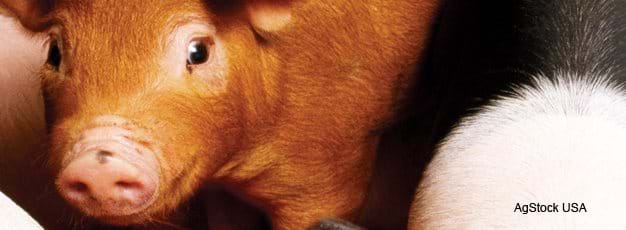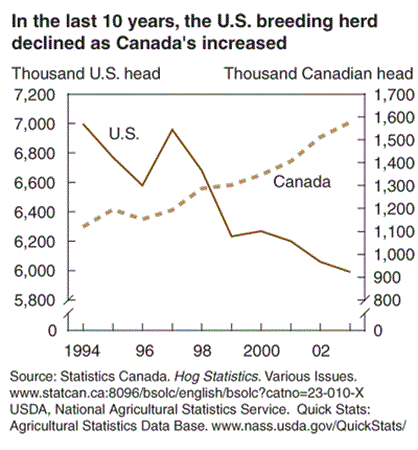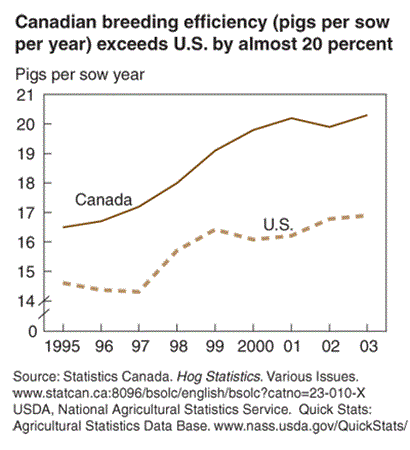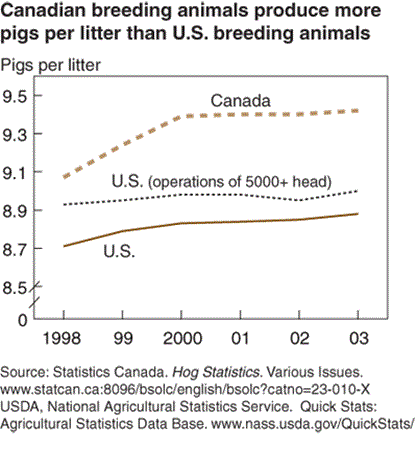U.S.-Canadian Hog Trade: Market Integration at Work

The United States is expected to import more than 8 million hogs from Canada in 2004, a far cry from the 921,000 head imported just 10 years ago. Moreover, unlike 1994, hog imports this year will likely continue to be skewed in favor of feeder pigs (see Glossary of Production Terms). Ten years ago, 44 percent of imported Canadian hogs were feeder pigs, versus almost 70 percent in 2004, with slaughter hogs making up the balance in each case. What economic factors changed in the past 10 years to create the demand for Canadian hogs, and, why has the trend developed toward feeder pigs? As with most questions pertaining to agricultural issues these days, these questions have no simple answers.
The rising influx of Canadian hogs has stirred up considerable controversy in the industry. On the one hand, the National Pork Producers' Council (NPPC), along with 19 State pork producer organizations and more than 100 individual U.S. pork producers, argue that Canadian hogs and feeder pigs established market share in the United States by using illegal subsidies from the Canadian and Provincial governments and by selling hogs and feeder pigs in the United States at less than fair value. The group has filed formal complaints with the U.S. Department of Commerce (DOC) and the International Trade Commission (ITC) (see Antidumping and Countervailing Duty Investigations Are Underway...).
On the other hand, the surge in Canadian hog exports to the U.S. is just one manifestation of profound structural changes that have occurred in the U.S. pork industry over the past 20 years and a trend toward tighter integration of North American pork production. A confluence of structural change in the U.S and significant policy changes in Canada likely set the stage for the growth of the Canadian hog industry and U.S. demand for hogs. In short, policy change in Canada has created a supply of hogs in excess of Canadian slaughter capacity, while structural change in the U.S. pork industry created a demand for hogs—particularly feeder pigs—in excess of domestic hog supply. Both sets of changes took place in an economic environment highly conducive to cross-border market integration. Many economists argue that the outcome has been a complementary system of hog production in North America, where favorable prices have attracted new Canadian resources to production of hogs—especially feeder pigs—to meet U.S. processors' demand for hogs. While these changes may well have brought hardship to some U.S. producers, many others have prospered. Moreover, U.S. processors and consumers have benefited from lower hog prices.
Prior to policy changes in Canada and structural change in the United States, it was reasonable to talk about 'the U.S. pork industry' and 'the Canadian pork industry' as separate, stand-alone industries because there was so little integration between them. But today, it is more accurate to talk about a North American pork industry, in which significant numbers of low-cost feeder pigs are produced in Canada, exported to U.S. Corn Belt States for finishing on low-cost U.S. corn and soybean meal, and then slaughtered in large, highly efficient U.S. processing facilities.
Indeed, pork production in North America is now a specialized activity that takes place in stages, at geographical locations where relative costs are minimized. Economists justifiably point to North American pork production as an application of the 'theory of comparative advantage,' which states that an economically efficient country specializes in the activities that make the heaviest use of the resources possessed by the country in greatest abundance.
Canadian Policy Changes Create Hog Production Opportunities
In the mid-1990s, the Canadian Government sharply reduced its subsidies to agriculture, thereby reducing its budget deficit and meeting its World Trade Organization (WTO) subsidy reduction commitments. The 1995 repeal of the Western Grain Transportation Act (WGTA), in particular, created an incentive to produce livestock in the Western Provinces, a region historically dedicated to grain production. The WGTA had subsidized rail transport of grain produced in the Western Provinces to Atlantic and Pacific export points. Absent these subsidies, feeding wheat and barley to livestock—particularly hogs—became more profitable than shipping the grain for export. Consequently, inventories of hogs and pigs in Manitoba—a Western Province—increased over 78 percent between 1995 and 2004. Manitoba's breeding herd increased more than 105 percent over the same period, and the Province is now the primary source of U.S. imports of Canadian feeder pigs.
Also contributing to the excess supply of hogs in Canada is a lack of slaughter capacity, compared with that of the United States. Although Canada’s slaughter and processing of hogs has increased significantly in the past 5 years, slaughter growth is trailing hog production. This year, Canada will slaughter and process almost 23 million hogs, a 44-percent increase over 1995. During the same period, hog production in Canada, as measured by annual pig crop, increased from 21 million to 31 million hogs, or 48 percent. Canada's ratio of pigs-to-slaughter rose from 1.27 in 1995 to 1.33 in 2002, reflecting the rising share of Western Canada's new hog production capacity dedicated specifically to raising feeder pigs for export to the United States.
U.S. Structural Change Creates Demand for Feeder Pigs
The growing excess supply of hogs in Canada was not simply a response to policy changes in Canada. There was also a simultaneous surge in U.S. demand, the result of significant structural changes in the U.S. pork industry over the last 20 years.
Until the mid-1980s, the U.S. pork industry consisted of a hog production component comprised primarily of many small, independently owned farrow-to-finish operations and a processing component with sufficient year-round processing capacity to accommodate large fall-winter slaughters. Currently, the sector is comprised of a smaller number of larger sized hog production and hog-processing operations, each increasingly reliant on contracting and vertical coordination to reduce risk and optimize year-round slaughter capacity utilization.
Advancing technology and the exit of small operations from the pork industry led to a dramatic reduction in U.S. breeding herd numbers. From 1994 to 2003, the breeding herd of swine in the U.S. declined by 14 percent. The breeding herds that underlie the new industry structure are products of state-of-the-art genetic technology and are managed aggressively—young piglets weaned at 14 days rather than at 20+ days, for example—to control disease and to maximize sow productivity. Relatively speaking, productivity increases in the U.S. breeding herd have partially offset the absolute decline in breeding herd numbers. Fewer breeding animals produce more pigs than just 10 years ago.
While producer adoption of technological innovations have led to productivity gains in swine breeding, probably a more important reason for the decline of the U.S. breeding herd has been the exit of small, independent hog operations from the industry. There are many reasons for the exit of the farrow-to-finish operations, but most economic research points to an aging population of hog producers unable or unwilling to compete with large production facilities on a cost basis and/or to meet packers' contract criteria.
More and more, U.S. hog production has become specialized in one aspect of production. Breeding/farrowing and finishing are two examples of specialized operations that characterize hog production today. Accordingly, Corn Belt hog operations now are more likely than not specialized in finishing feeder pigs on locally grown corn and soybean meal. In turn, the packing plants increasingly contract with a small set of large production facilities in order to ensure steady supplies of uniform, high-quality hogs.
Lower Costs Favor U.S. Packers
The U.S. pork industry has also seen a decline in slaughter capacity since the mid-1990s. At its peak, U.S. packers could slaughter roughly 118 million head of hogs per year. Currently, annual U.S. slaughter capacity is closer to 103 million animals. This decline reflects a departure from the industry's past willingness to maintain excess capacity—that is, to underutilize facilities for almost three-quarters of the year (January-August)—in order to accommodate large seasonal (September-December) slaughters.
As the processing industry became dominated by new, very large slaughter plants that maximize throughput year-round in order to lower fixed costs, high-cost, lower capacity plants were forced to close, thus reducing total U.S. slaughter capacity. The industry now accommodates large fall-winter slaughters by adding a second shift and/or by slaughtering animals on Saturdays. 'Chain speeds' (the speeds at which the animals are killed and processed into pork products) are also accelerated during periods of high demand, increasing output of pork. Thus, rather than holding excess capacity for periods of high slaughter demand, the industry uses a smaller slaughter capacity more intensively.
However, while U.S. slaughter capacity has fallen, U.S. hog production capacity has fallen even faster. To maximize throughput, yet still maintain capacity to accommodate heavy slaughter periods, U.S. packing facilities bid up the price of hogs. In the open-border situation that now characterizes U.S.-Canadian live hog trade, U.S. packers can 'outbid' Canadian packers for slaughter hogs. U.S. packers can do so because of lower costs that derive partly from lower U.S. wages and more flexible work rules. Work rules in the U.S. allow Saturday slaughters and second shifts that have never been common practice in Canada.
Exchange Rate Nets Further Discounts for U.S. Buyers
The U.S.-Canadian dollar exchange rate has been a major factor driving U.S. demand for Canadian hogs. Between November 1996 and January 2002, the U.S. dollar appreciated almost 20 percent against the Canadian dollar, with the Canadian dollar falling to $0.625 in January 2002. When the U.S. dollar appreciates against the Canadian dollar, Canadian sellers 'net' more Canadian dollars after converting the U.S. dollars received from the sale of animals. Each time the U.S. dollar appreciated against the Canadian currency between the mid-1990s and 2002, the Canadian hog supply chain garnered an exchange rate premium. This premium, coming just as the Canadian hog export business was establishing commercial links in the United States, proved a powerful marketing tool for sellers of Canadian feeder pigs and hogs. With the help of exchange rate dynamics, Canadian feeder pigs could become more competitive, for example, than pigs grown in Oklahoma. U.S. hog finishers buying feeder pigs benefited by paying lower prices for feeder pigs than might have otherwise been the case.
The Canadian dollar began to appreciate against the U.S. dollar in 2002, but this did not stop the flow of hogs into the U.S. The rise in the Canadian dollar appears to have led to a decline in the competitiveness of Canadian pork products in Asian markets, particularly Japan, the world's largest pork importer, with U.S. pork becoming more competitive against Canadian pork. Canadian pork exports declined, and slaughter margins of Canadian processors decreased, obliging them to offer lower prices for hogs. Canadian hog producers responded by exporting more slaughter hogs to the United States. Whichever direction the Canadian dollar goes in the future, exchange rates will continue to affect the quantity and type of Canadian hog (i.e., feeder pig or slaughter hog) traded in the United States.
Canadian Breeding Operations More Efficient
It was not only the strong U.S. dollar between 1996 and 2002 that contributed to the competitiveness of Canadian hogs in U.S. markets. Perhaps even more important, the Canadian hog industry has gained a competitive edge from breeding herd efficiencies. Official Canadian statistics show Canadian breeding herds to be significantly more efficient than U.S. herds, in terms of the all-important measures of pigs per litter, and pigs per breeding animal per year. The U.S. breeding herd has, according to USDA statistics, also become more efficient with the exit of small, inefficient farrow-to-finish operations. However, there remains a wide disparity between Canadian and U.S. efficiency indicators, suggesting in stark terms why Canadian pigs may underprice feeder pigs produced in the United States.
For example, in 1995, a Canadian breeding animal produced 1.9 more pigs per year than a U.S. breeding animal. By 2003, that gap had widened to 3.4 pigs per animal per year, in favor of Canada's breeding herd. Data on pigs per litter tell the same story. Canada's breeding herd produces 0.4 pigs per litter more than U.S. herds on farms with more than 5,000 head, assumed to be most able to take full advantage of scale economies. Canada's greater breeding efficiency contributes to lower production costs, which, in combination with favorable exchange rates, boost the competitiveness of Canadian feeder pigs and slaughter hogs, compared with animals produced in the United States.
Another important factor contributing to the efficiency of Canadian breeding herds is the cool Canadian climate and lower herd densities. Both factors serve as powerful dampers on the development and spread of disease, the bane of every swine producer, regardless of location. Being located farther north than the United States, Canada has a cooler climate that is less hospitable to swine diseases. Cooler weather also improves lactation quantity and quality in nursing sows, thus enhancing litter health.
Moreover, the swine population density is much lower in Canada than in the United States, particularly in Manitoba, where hog operations are typically located many miles apart. In Iowa and southern Minnesota, the primary destinations of most feeder pigs sold in the United States, hog operations are often separated by just a couple hundred yards, increasing the probability that a disease will spread to adjoining operations. Disease outbreaks in swine herds are not unusual events. When an outbreak occurs in operations located in Corn Belt States, the probability of the disease spreading beyond the originating herd is larger than if the same disease were to occur in the more widely dispersed Canadian hog production industry.
Hog producers also point out that swine diseases are extremely difficult to totally eradicate once they have become established. Thus, from a disease standpoint, U.S. hog producers are at a disadvantage with respect to Canadian hog producers simply because hogs have been raised in U.S. Corn Belt States for more than a century, whereas the hog industry in Western Canada is relatively new. Swine diseases are not as significant a factor in a relatively new industry as they are in the more established hog industry in the United States.
Market Dynamics Strengthen Integration of North American Pork Markets
So, why does the U.S. import so many Canadian hogs? A combination of policy change in Canada and significant industry restructuring in the United States certainly set the stage. The cheap Canadian dollar between 1996 and 2002 in terms of U.S. currency likely provided a windfall to sellers of Canadian hogs in the United States. But the key to the increase in U.S. hog imports may well be the dynamics of events—the order and the speed at which they occurred. Changes in structures of U.S. hog production and processing, although not independent of each other, did not occur as a perfectly timed and coordinated sequence of events. In order to maximize throughput and still maintain capacity to accommodate heavy slaughter periods, U.S. packing facilities bid up the price of hogs. Years ago, when an individual slaughter plant bid up hog prices, profits would have accrued only to producers located close to the plant. Now, prices bid by packers in Iowa and Kentucky to maintain throughput are high enough to attract producers located as far away as Manitoba and Ontario. The lower cost base of the U.S. slaughter industry, relative to Canada's, allows U.S. packers to consistently bid aggressively for hogs, and thus functions as a primary driver of U.S. live hog imports.
Pork production in North America is arguably an application of the theory of comparative advantage. Canada mainly specializes in the stage of pork production where it is most efficient—feeder pig production—and the United States tends to specialize in finishing hogs—particularly in the Corn Belt States, where costs of corn and soybean meal are minimized—and in processing finished hogs in large-scale processing facilities that can minimize costs. Consumers in North America and Asia reap the benefits of low-cost, high-quality pork products.
<a name='box1'></a>Glossary of Production Terms
Feeder pigs: A young pig weighing between 10 and 60 pounds; such animals are bred for finishing. The distribution of feeder pigs imported from Canada is skewed in favor of segregated early weaned (SEW) pigs that weigh about 10 pounds. SEW pigs are products of a system that breeds and farrows sows on one farm, weans the pigs relatively early (10-18 days), and then removes the weaned pigs to a new site, separated from the first by about a mile, until they are about 8 weeks old. Then the pigs are moved again to another separate site until they are ready to be sold. Proponents of the SEW system argue that it delivers as much as a 20-percent boost to growth rate, provides a predictable production system, reduces the impact of disease, and reduces costs of production. Its detractors argue that the system is overkill—overcapitalized and reproductively awkward.
Finishing: The process of feeding a feeder pig a ration of primarily corn and soybeans, usually for a 6-month period, until it reaches slaughter weight of between 260 and 270 pounds.
Finishing operation: A production enterprise specialized in finishing feeder pigs. Currently, feeder pigs are typically bought and sold under contract arrangement, as a component in a vertically coordinated or vertically integrated pork supply chain.
Slaughter hog: A hog of roughly 6 months of age that has achieved slaughter weight.
Farrow-to-finish: An operation that includes all stages of production from breeding through finishing.
Farrow: To give birth to a litter of pigs.
Processors/Packers: Enterprises engaged in the slaughter stage of pork production. The objective of the slaughter stage of the U.S. pork industry is to produce uniformly high-quality products that are increasingly differentiated, branded, and more highly processed than in the recent past. To achieve its objective, the industry has adopted various new business models, built around vertical coordination via contracting (production and marketing), or by outright ownership of upstream assets (vertical integration), all in the interests of guaranteeing on-time delivery of uniform, high-quality hogs.
<a name='box2'></a>Antidumping and Countervailing Duty Investigations Are Underway . . .
On March 5, 2004, the National Pork Producers' Council (NPPC), along with 19 State pork producer organizations and more than 100 individual U.S. pork producers, filed petitions with the U.S. Department of Commerce (DOC) and the International Trade Commission (ITC), arguing that, in 2003, Canadian exporters of hogs and feeder pigs established market share in the United States by using illegal subsidies from the Federal and Provincial governments of Canada, and by selling slaughter hogs and feeder pigs in the United States at less than fair value. The petition requests trade relief in the form of antidumping and countervailing duties, each of which, if imposed, would effectively increase U.S. prices of feeder pigs and slaughter hogs imported from Canada.
Investigations of the claims of the NPPC et al. are underway at both the DOC and the ITC. The investigations will examine financial records of individual Canadian hog producers, as well as the structures of and disbursements from Canadian government programs that assist agricultural producers. The role of the DOC is to make preliminary and final determinations on countervailing duty (CVD) and antidumping (AD) questions. The CVD question concerns the legality of financial support given to Canadian hog producers by the Federal and Provincial governments of Canada, and whether CVDs should be levied to compensate U.S. producers for Canadian subsidy support. The AD question concerns whether Canadian hogs were sold in the United States at selling prices of less than fair value in 2003, in which case, antidumping penalties are to be assessed. The role of the ITC is to make preliminary and final determinations as to whether imported Canadian hogs either materially injured or threatened material injury to the U.S. hog production industry in 2003.
So far:
- In August 2004, the DOC announced a negative preliminary determination in the CVD investigation, finding that the total net subsidy to Canadian hog producers by the Canadian Government is de minimus—that is, negligible and thus too small to be countervailed.
- In October 2004, the DOC issued a positive preliminary determination with respect to the dumping charge. As a result of the ruling, beginning in late October 2004, Canadian exporters of live hogs to the United States have been required to post a cash deposit or a bond, equal to antidumping penalties, or roughly 14 percent of the value of the imported Canadian hog or feeder pig.
- In May 2004, the ITC made a preliminary determination that '...there is a reasonable indication that an industry in the United States is materially injured by reason of imports from Canada of live swine...'
Final determinations from DOC on the CVD and the AD investigations are due in early March 2005. The ITC is to issue a final determination concerning injury to the U.S. hog production industry in late April 2005. If DOC makes affirmative determinations in either the CVD or the AD investigations, and the ITC makes an affirmative final injury determination, countervailing duties and/or antidumping penalty orders will be issued.
Market Integration in the North American Hog Industries, by Mildred Haley, USDA, Economic Research Service, November 2004




